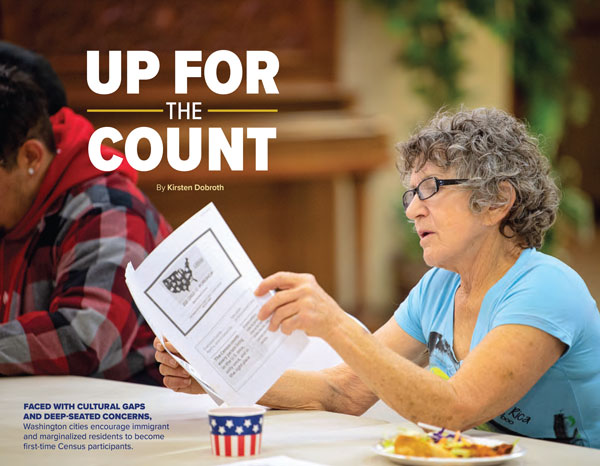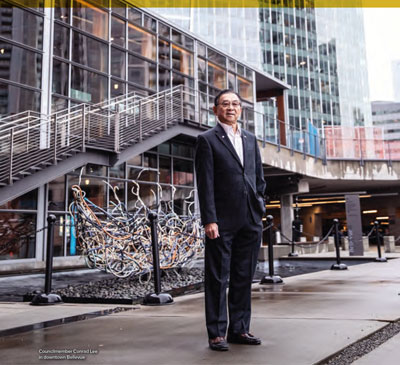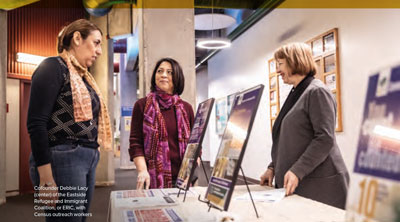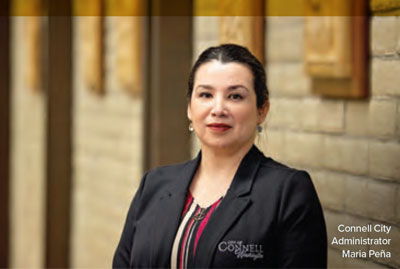The decree for a recurring complete count of every person living in the United States is one of the first mandates of the US Constitution. Article I, Section II spells out the calculus that will be used to determine the number of seats states are allotted in the US House of Representatives. It’s a complicated formula (“determined by adding to the Whole Number of Free Persons, including those bound to a Service for a Term of Years and excluding Indians not taxed, three-fifths of all other persons”), but the ultimate results are determined by a single monumental effort: a nationwide enumeration “that shall be made within three Years after the first Meeting of the Congress of the United States, and within every subsequent Term of ten Years.”

The first decennial Census was held in 1790, with enumerators—bookkeepers tasked with tallying members of every household in the young nation—riding door to door on horseback, asking anyone who answered for the name of the head of the household, the names of anyone else residing there, and those persons’ status within one of five categories: free white males age 16 and older, free white males under the age of 16, free white females, all other free people, and slaves. The nascent nation’s first count wasn’t without controversy; both George Washington and Thomas Jefferson (the first Census director) were skeptical of the final tally—3.9 million—suspecting that the real number was far greater. In light of the challenge of enumerating homesteaders secluded deep in the woods of newly claimed territories, it’s not hard to imagine that many thousands slipped through the cracks on that first count.
In 1860, when Washington Territory was first included in the US Census, its population was tallied at 11,594, including 11,138 whites, 30 “free coloreds” and 426 “Indians.” (Tasked with being more thorough on their second attempt, when enumerators returned to Washington in 1870, they counted nearly 15,000 residents in that last category.) By the 11th decennial Census in 1890, Washington’s first as a state, the population had exploded to 349,390 from just 75,116 10 years earlier, an astounding increase of 365 percent. While Manifest Destiny contributed to that growth, so did the Hollerith Machine, a revolutionary electronic counting device (its namesake founded one of the companies that would later become IBM) first used in the 1890 Census that dramatically improved the reach, and accuracy, of enumeration.
Fast-forward to 2020, the 24th decennial Census. For the first time in history, the US will attempt to count itself predominantly online, betting that 55 percent of the population will opt in and answer questions via smartphones and computers, a first step toward rendering door-to-door enumerators (who still will have to count the Luddites) obsolete. With its population surging, Washington, which gained a congressional seat following the 2010 Census, may stand to gain an additional seat from this year’s count, too: according to Census Bureau estimates, the state’s population hovers somewhere around 7.5 million, a 13 percent increase from the last Census. And there’s more at stake to verifying that uptick via the Census than gaining additional seats in the House of Representatives; more people means more money from the federal government, with the New York Times estimating that as much as $900 billion in federal funding will be doled out annually at the state and local levels based on the results of the upcoming 2020 count.
The introduction of new digital methods, however, doesn’t eliminate the challenges—including the remote residents and racial bias that have compromised the Census since the earliest counts—of securing an accurate tally of the population. Washington alone “has more than 1.6 million residents from historically ‘hard to count’ population groups, including communities of color, Native Americans both on and off tribal lands, immigrants and limited English speakers, young children and rural residents of all backgrounds,” according to an opinion piece published recently in the Seattle Times.
Bellevue provides an instructive example of how cities are grappling with this reality as the 2020 Census approaches. Since 2010, Bellevue has added an estimated 22,937 residents, a 19 percent increase, making it the fifth-largest city in Washington (behind Seattle, Spokane, Tacoma, and Vancouver). About 5 percent of this growth comes from annexation, but the remaining 14 percent has been driven largely by newcomers from outside the United States.
“Bellevue has been growing in terms of its racial and ethnic diversity. We have about 17 percent of our population who are recent immigrants, who entered the United States after 2010—so they’ve never actually participated in a Census before,” explains Bellevue Senior Planner and Demographer Gwen Rousseau. “The biggest thing really is awareness: what is the Census, and how does it relate to people in Bellevue?”
Convincing all of those newcomers of the value of being counted in 2020 matters for everyone living in Bellevue, whether they are citizens or not. Since 2010, the City of Bellevue has received over $76 million in federal and state funding for transportation projects, over $7 million for parks projects, and $5.8 million for Community Development Block Grants. The Bellevue School District has received an average of nearly $11 million annually for local school district programs—nearly $100 million, all guided by the population count gathered in the 2010 Census.
“We need to provide roads, we need to provide health care, we need to provide public safety and community development,” says Bellevue Councilmember Conrad Lee. “If we are not counted, the money that we pay—the taxes—goes to somebody else, somewhere else.”
If we are not counted, the money that we pay—the taxes—goes to somebody else, somewhere else.
– Conrad Lee, Bellevue Councilmember
Lee is the longest continuously serving member of the city’s council, having joined in 1994, and is its first minority councilmember; he was selected as deputy mayor in 2010–11 and mayor in 2012–13. The former Boeing engineer—who immigrated to Bellevue from China in 1967—cites regional tech jobs, especially at Microsoft, as the main draw for a surge in highly skilled and educated workers moving to the area from overseas in recent years. That uptick in immigration means that 42 percent of Bellevue residents now speak a language other than English at home—according to the US Census Bureau’s 2018 American Community Survey—with 37 percent of Bellevue’s population identifying as Asian and 6 percent as Hispanic, the two largest groups other than white residents.
“Bellevue’s immigrant population has increased by about 36 percent since 2010. That’s a big chunk of people who have not been properly educated to understand the importance of the Census,” explains Lee. “It’s a practice that happens every 10 years, and in the countries immigrants come from, they don’t have that practice—they get the form in the mail, and what they do is just throw it away—especially when there’s also a language barrier and cultural barriers.”

Add to that challenge lingering fallout from the aborted “citizenship question.” In late 2017, US Commerce Secretary Wilbur Ross announced that the 2020 Census would include a question about citizenship along with its accustomed questions about sex, race, and age. The Department of Justice had argued that the question would help protect voting rights for the country’s minority residents by helping to enforce the Voting Rights Act, which was passed into law in 1965 and prohibits racial discrimination in voting. But the New York Times reported that the government’s own figures estimated that including a citizenship question on the 2020 census would undercount about 6.5 million—largely minority—residents and would cost Arizona, California, Florida, Illinois, New York, and Texas congressional seats.
There was also concern from immigrant communities that noncitizens who answered the question would be targeted for deportation by US Immigration and Customs Enforcement (ICE) agents. Census officials, for their part, insisted their data would not be shared with any other agency, citing laws that prohibit the release of “personally identifiable information about an individual to any other individual or agency until 72 years after it was collected for the decennial Census” by the US government. Nevertheless, many minority and immigrant advocates had concerns that answers to the questions could affect communities at large and expose them to targeting from ICE—or that the information would be released anyway.
In July, after the US Supreme Court ruled that the federal government hadn’t provided justifiable reasoning for adding the question, the Census Bureau announced that citizenship would not be enumerated. Still, advocates and local government officials working on Census outreach and education in Washington say that even though the citizenship question was nixed, the damage had already been done.
“I understand how the Census benefits the city, and the dollars that come back to the city, and that’s a good thing—I get all that,” says Connell City Administrator Maria Peña. “But that is not what matters most to people who are very afraid that it can be used against them.”
Connell, which was known as Palouse Junction when it served as a watering station for Northern Pacific locomotives in the late 19th century, is a tightly knit enclave at the intersection of two highways in rural southeastern Washington. In 2010, according to the last Census, the city’s population totaled 4,210 residents; in 2018, the Census Bureau estimated that Connell’s population had surged to 5,566, a whopping 32 percent increase. Like Bellevue, Connell has seen its growth driven primarily by noncitizens, immigrants from Mexico and Latin America drawn to regional jobs in food processing and agriculture, with local chemical plants and Connell’s correctional facility—the largest in the state—also making up a sizable chunk of the town’s employment opportunities.
After news about the proposed citizenship question spread, creating unease, Peña attended Census trainings hosted by the Washington City Managers Association, AWC, and the Census Bureau to try to learn more, so she could take back a coherent message to her spooked constituency. At one city managers meeting, she asked a Census Bureau official what would happen if Connell residents chose not to answer the question when filling out their form. The response: Anyone who feels inclined to skip the citizenship question shouldn’t bother filling out the form at all.
“It just left me more and more frustrated,” Peña says. “Everyone who was in that room understands the fear that is out there and wants to get an accurate count and promote the Census, and that didn’t help.”
Peña, who has been employed by the City of Connell for over 20 years, was involved with organizing the city’s outreach efforts for the Census in 2010. This time around, she is hearing more concerns—specifically within minority and immigrant communities—that Census data might be used to target noncitizens for deportation. Despite Census Bureau assurances that personal information would remain confidential and not be shared with other federal agencies, ICE raids in the area only helped fuel such anxiety. In June 2018, with the citizenship question yet unresolved, the Tri-City Herald reported that ICE agents had arrested an undisclosed number of migrant workers in pre-dawn raids at orchards in neighboring Basin City, which led to a small protest outside the Spokane County Jail.
“I had this personal struggle with it,” says Peña about recommending that local residents fill out the Census. “I know these people from my church and the community groups I’m affiliated with. When the question was asked to me about where I stood on it at the time, I couldn’t answer that.”

Census outreach specialists in other communities, including Bellevue, are similarly struggling to quell lingering angst, as well as outright misinformation.
“We’re finding that people still think either that the [citizenship] question is going to be on there, or because they read something about citizenship and the Census, they think you have to be a citizen in order to complete the Census,” says Eastside Refugee and Immigrant Coalition (ERIC) cofounder Debbie Lacy. “It was a significant barrier, and it will remain one until the launch.”
Lacy started the Bellevue-based organization in 2002 in response to the police officer–involved shooting of an unarmed, non-English-speaking Guatemalan man in the city in 2001, and to more general anti-Muslim and anti-immigrant sentiment that followed 9/11. Since then, ERIC has worked as a conduit between immigrant communities and local government officials who represent them, and the group helps increase access to social services and programs provided to immigrants and refugees across East King County. Bellevue—in collaboration with other Eastside cities like Redmond, Kirkland, Issaquah, and Sammamish—has partnered with ERIC to expand outreach and education efforts to minority communities in preparation for the upcoming Census.
When you have a population that’s one-third foreign-born, we just knew we needed a lens of intercultural competency and equity and a community-focused response to make sure that we could have a good effort for this Census.
– Debbie Lacy, ERIC cofounder
“If you take all those five cities, it’s about one out of every three people living in those cities that was born outside of the US,” emphasizes Lacy. “When you have a population that’s one-third foreign-born, we just knew we needed a lens of intercultural competency and equity and a community-focused response to make sure that we could have a good effort for this Census.”
Part of that comes down to money. Counting every person in the country is expensive; despite perpetual increases in costs for the decennial count, federal funding for local Census outreach efforts has declined.
“There are concerns about the government, especially in the immigrant population,” former Census Bureau Director John Thompson told the National Press Club after resigning from his post in 2017, estimating that marketing efforts and preparation for the 2020 Census had been underfunded by $200 million. “That’s why it’s going to be so important to do the work with the partnerships and the local organizations to get the word out.”
To that end, the King County Regional Census Fund, administered by Seattle Foundation, has issued grants totaling $1.29 million to 57 nonprofits to support Census outreach efforts across the county. For East King County, those efforts include Census outreach booths at cultural events, Census trainings at community centers, and programs to support students from the Bellevue School District (in which 97 different languages are spoken) to serve as trusted messengers within their communities. Doing its part, the City of Bellevue contributed $50,000 to the East King County Regional Census Fund when the city launched its “Bellevue Counts” campaign last April.
“The challenges are bigger because we’re getting less money from the federal government,” says Bellevue’s Lee. “But most of the work, if it’s done properly by local government, should compensate for the lack of money from federal government.”

In Connell, Maria Peña has also leaned on local organizations to help with Census outreach, education, and messaging. She found that the most impactful Census training for her community was organized by the Washington Immigrant Solidarity Network (WISN), an immigrant-led nonprofit specializing in law, education, policy, and labor that had initially become active in the area following the 2018 Basin City ICE raid. WISN advocated for assuaging fears within Connell with a message that participating in the Census count was a risk worth taking—because being counted meant having a voice.
“I finally had the answers I needed,” Peña says, “but I didn’t have the resources to put this information out there.”
I finally had the answers I needed, but I didn’t have the resources to put this information out there.
– Maria Peña, Connell City Administrator
To remedy that situation, Connell partnered with a local chapter of the United Way, which had received a grant from the Census Bureau specifically to hire a Census outreach worker in Connell.
“Now what I’m working on is trying to find someone to hire,” Peña says, which is a good problem to have.
Back in Bellevue, Lee thinks that part of that messaging should revolve around what may be lost: funding and representation in Washington, DC. But it’s also about what immigrant and refugee groups can gain from being included in the 2020 count, and about what Bellevue can gain in the process: a community that is more engaged with its city.
“We are going through an exercise that actually provides us a connection to our local community that is hard to reach,” Lee says. “Normally, when people come to us when they’re immigrants, there’s some problem—they need services, they’re hurt, or they did something bad. . . . Now we’re actually reaching out to them to try to build a relationship, hopefully a trusted relationship, for the future. So this is a great way, if we do our job right, to have 100 percent of our community talking to us and working with us. And that’s the ultimate goal of a representative government.”